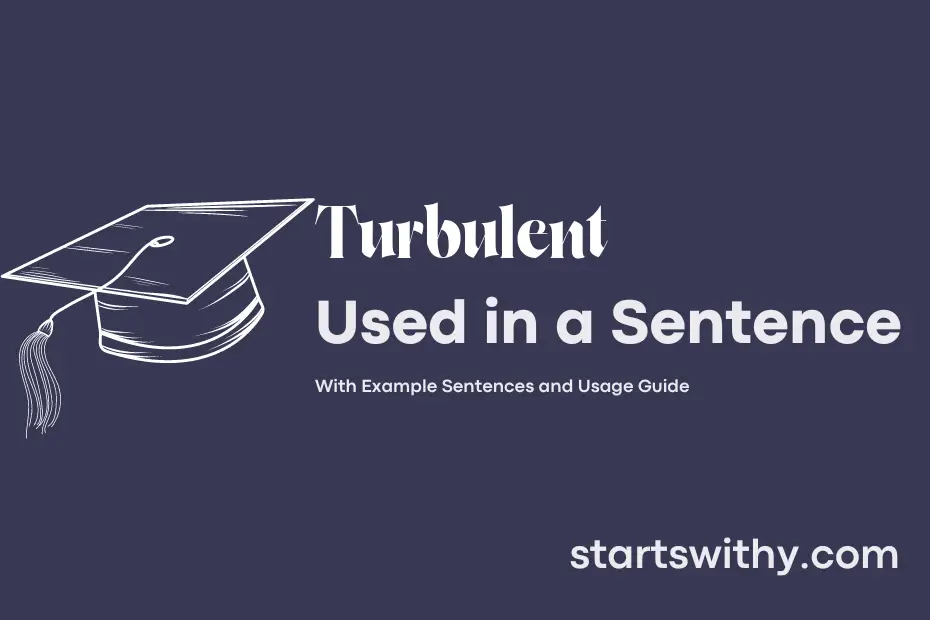Have you ever struggled to maintain stability in a turbulent situation? The word “turbulent” describes disorderly and chaotic conditions that make it challenging to stay steady or calm.
In turbulent times, individuals may find it hard to navigate through unpredictable events or emotions, leading to feelings of unease or unrest. This term is often used to depict turbulent waters or weather, but it can also be applied to turbulent relationships, markets, or periods in history.
7 Examples Of Turbulent Used In a Sentence For Kids
- The turbulent waves crashed loudly on the shore.
- The wind made the clouds look turbulent as they moved fast.
- The river was very turbulent after the heavy rain.
- The tree branches swayed in the turbulent wind.
- The turbulent storm passed quickly and left behind a rainbow.
- The turbulent ocean water splashed up onto the beach.
- The airplane shook in the turbulent air during the storm.
14 Sentences with Turbulent Examples
- Juggling multiple assignments and extracurricular activities can make the college experience quite turbulent.
- The turbulent effects of last-minute cramming for exams can lead to stress and anxiety among students.
- Navigating through the competitive job market can be a turbulent journey for college graduates.
- Students often face turbulent times when they have to balance social life with academics.
- Managing finances as a college student can sometimes result in a turbulent financial situation.
- The transition from high school to college can be a turbulent period of adjustment for many students.
- Choosing a career path can seem turbulent and overwhelming for college students.
- Group projects can sometimes lead to turbulent disagreements among team members.
- Balancing a part-time job along with studies can create a turbulent schedule for college students.
- The turbulent nature of relationships in college can take a toll on students’ emotional well-being.
- Handling peer pressure can be a turbulent experience for many college students.
- The process of finding affordable housing near college campuses can be quite turbulent for students.
- Navigating public transportation in busy cities can be a turbulent experience for college students.
How To Use Turbulent in Sentences?
To use Turbulent in a sentence, start by identifying a situation or description that involves a lot of chaos, disorder, or unrest. For example, you could say “The turbulent waters made it difficult for the small boat to stay afloat.” In this case, the word “turbulent” is used to describe the rough and choppy nature of the water, indicating a state of instability and unrest.
When using Turbulent, consider the context in which you are using the word. Is it describing a physical environment like a stormy sea or a swirling tornado, or is it used metaphorically to describe a tumultuous period in someone’s life or a chaotic political situation? Being aware of the context will help ensure that you are using the word accurately.
Additionally, pay attention to the pronunciation of Turbulent (ter-byuh-luhnt) to ensure that you are able to articulate it clearly in your sentence. This can help convey your message effectively and avoid any misunderstandings.
Overall, remember that Turbulent is a strong and descriptive word that conveys a sense of disorder and instability. By using it thoughtfully in your sentences, you can paint a vivid picture for your readers or listeners and engage them in your message.
Conclusion
In conclusion, the examples of sentences with the keyword “turbulent” highlighted situations marked by chaos, disorder, or unrest. From describing a turbulent relationship to turbulent weather conditions or turbulent market fluctuations, the word was used to convey a sense of instability and unpredictability. These sentences illustrated how “turbulent” can be applied to a wide range of scenarios where there is turmoil or agitation.
Ultimately, the varied contexts in which “turbulent” was used emphasize the versatile nature of the term and its ability to capture the essence of upheaval and turbulence in different settings. Whether referring to emotional turmoil, a turbulent flight, or turbulent waters, the word effectively conveys a sense of disorder and disturbance in vivid and impactful ways.



